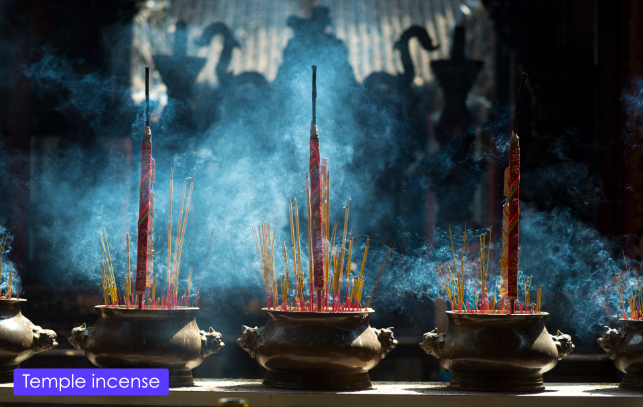Vietnam is an ethnically diverse and pragmatically tolerant country, in which several world religious have established themselves upon the culture and co-exist along with more traditional animist beliefs.
Underneath the overlay of religious accoutrements and practices of the imported religions however, the precepts of animism still widely pervade everywhere in Vietnamese culture, including a universally held reverence for the ancestors and many other rituals with their roots in ancient shamanistic magic.
In these naturalistic practices, spirits were held to inhabit all things, and these spirit forces of nature had such a crucial bearing on the welfare and survival of the people that it was considered essential to make offerings and ritual sacrifices to ensure the continuation of favour from these inescapable powers.
Likewise, internally, spirits are also held to inhabit people, bestowing health and good fortune upon them, but require continual care and attention to ensure they confer their blessings and remain beneficent toward their host.
Each Vietnamese village has its own deity, which can take various forms of god-spirit, and can even include historical personages.
Given Vietnam’s millennia-long occupation by China from the second century BC, it is not surprising that the influence of many traditional Chinese observances found their way into Vietnamese practices, including worship of the kitchen God, even though considerable hereditary antipathy to Chinese rule was commonplace, a strong emotion which still lingers within many Vietnamese people today.

Chinese beliefs embodied by Confucianism and Taoism were introduced during this time and indeed, one of Hanoi’s most famous ancient buildings, the Temple of Literature, is unmistakably a Confucian monument and its principles of social order still influence the country today. Likewise Taoist thought, though not practiced in its original form, has left an influence within Vietnamese folk traditions and has also been absorbed into modern new-age hybrid religions, such as Cao Dai.
The earliest of the foreign religions to enter and shape Vietnam was that of Buddhism, firstly Mahayana Buddhism in the second century BC and Theravada Buddhism some four centuries later, but it was not until the tenth century, following liberation from Chinese rule that Buddhism acquired state sponsorship under the auspices of the Ly Tran dynasty.
During the eleventh century, the Cham people, whose heartland stretched from Hue to the Mekong Delta, and were originally the inheritors of the Hindu traditions of the Cambodian Angkor era, were introduced via trade to Islam. Vietnam would eventually conquer and subsume the Champa Kingdom, absorbing it wholly into Vietnam, during which most of the surviving Cham fled.
However, a small enclave of Cham remained in the area of Nha Trang and, despite considerable persecution in the past, still practice both Hinduism and Islam today, though the Islam of Vietnam is characteristically fused with animist practices and still retains many elements drawn from Hinduism.
Christianity, in the form of Catholicism, first arrived with Portuguese missionaries in the 16th Century, but initially made little impression. A century later, however, its sphere of influence increased in the communities exposed to Spanish missionaries in Tonkin and French Missionaries in the south of the country.
For a time, this limited presence of Catholicism was able to sit peacefully within greater Vietnamese culture, but the church’s pernicious attempts to get a Catholic convert onto the throne would lead to a clampdown, a move which in turn was used as a pretext to justify the French invasion and subsequent colonisation of Vietnam.
As elsewhere in the world, Catholic Christianity often relied on extreme intimidation and violent force to get its dubious message of peace across.
Protestantism, having supplanted Catholicism in northern Europe, eventually found its way into Vietnam via a Canadian missionary who arrived in Da Nang in 1911, and had some small success in making converts. Nevertheless, despite its best efforts, Christianity in both forms, though by no means insignificant, today remains something of a niche religion in Vietnam.
In the nineteenth and twentieth centuries, a trend emerged globally, where various religious entrepreneurs sought to establish their own, often-lucrative religions, combining the most appealing aspects of several religious beliefs in a ‘catch all’ to disenchanted followers of these original faiths.
So too in Vietnam, following a ‘revelation’ in 1921 to its founder, Ngo Van Chieu, the Cao Dai religion, based near Saigon, where it enjoys considerable popularity, encapsulated the teachings of many of ‘God’s prophets’ into a single movement, with elements from Buddhist, Taoist, Confucian, Christian, Islamic and spiritualist traditions brought together with a sprinkling of theosophical mysticism, represented by the ‘all seeing eye’, the movement’s principal symbol.
As well as all the familiar main players of the world religions, the movement’s revered saints include figures such as Joan of Arc, Lenin, Victor Hugo, Shakespeare and Louis Pasteur among its illustrious pantheon.
Another modern, though less successful Vietnamese religion is Dao Hoa Hao, which is largely drawn from Buddhism and was created in 1939 by Huynh Phu So, who made several prophesies for the future of Vietnam. He and his followers were heavily involved in the politics of the time, famously supporting the Japanese occupation. The movement is quite small and survives in its birthplace in the Mekong Delta and among a small group of emigres in California.
During the heyday of Communist rule in Vietnam, many religions came under the characteristic persecution of the early phases of its rule. In the modern era, however, the right to freedom of belief and non-belief has been enshrined in Vietnamese law, allowing all Vietnamese citizens to follow their predilections without prejudice or interference, providing their practices remain within the law of the land.